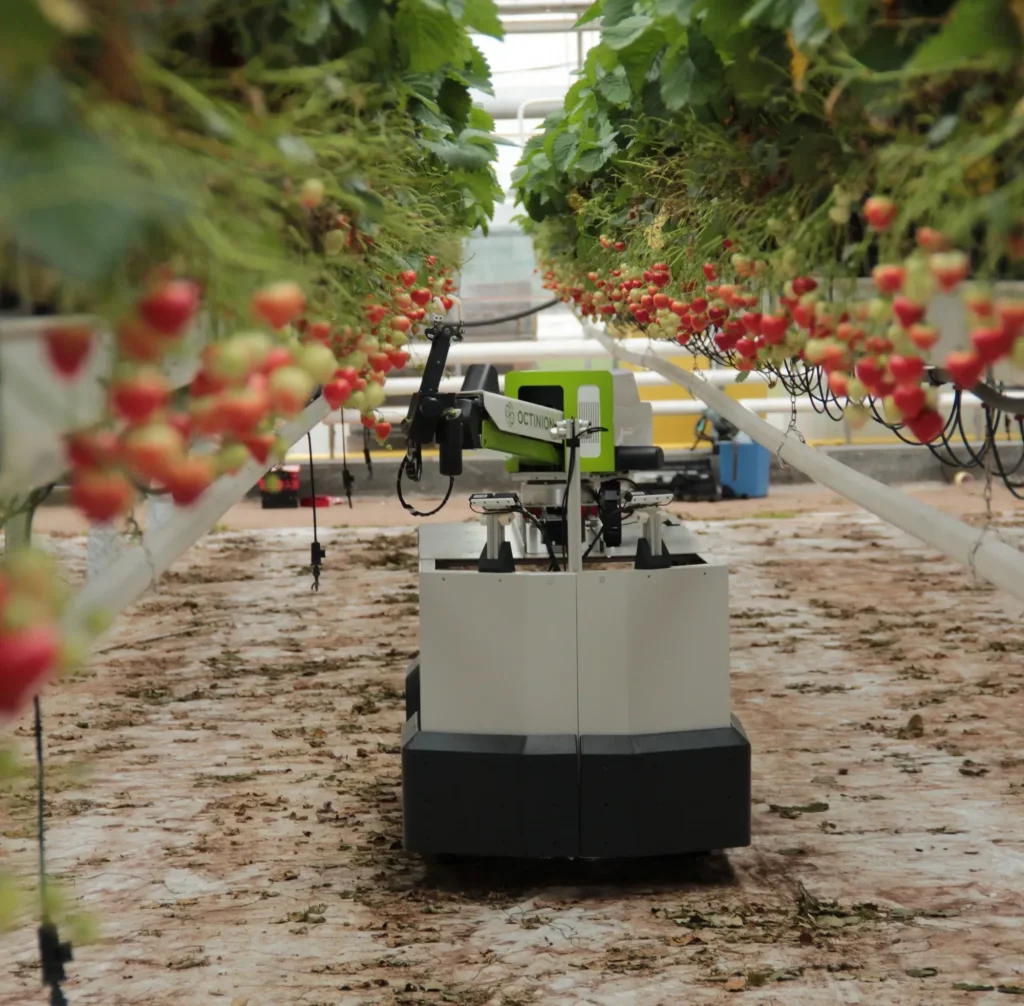Fruit picking robotics are revolutionizing agriculture by integrating innovative technologies that streamline harvesting processes. With the advent of autonomous fruit harvesters, fruits can be collected with unprecedented efficiency and accuracy. This not only minimizes labor costs but also enhances the quality of the produce through precise handling, as seen with advancements like GRIP-tape fruit handling. By leveraging drone technology in agriculture, these robotic solutions can operate tirelessly, ensuring that farms maximize their yield and reduce waste. As agritech innovations continue to shape the future of farming, the role of fruit picking robotics is becoming increasingly critical in sustaining global food supply.
The emergence of automated harvesting systems signifies a major shift in agricultural practices, enhancing how fruits are collected and managed. These advanced machines, often referred to as robotic farming solutions, utilize cutting-edge technology to ensure optimal harvesting conditions. Drones and other machinery equipped with smart sensors and AI capabilities can now efficiently assess fruit readiness and execute precise picking tasks. This alternative approach not only addresses labor shortages but also increases productivity and food quality. With systems that focus on gentle handling, such as GRIP-tape technology, the future of fruit collection promises to be both effective and sustainable.
The Rise of Fruit Picking Robotics in Agriculture
Fruit picking robotics are revolutionizing the agricultural landscape, utilizing sophisticated technologies that enhance efficiency and sustainability. At the forefront of this revolution are autonomous fruit harvesters, like Tevel’s Flying Robots, which leverage drone technology in agriculture to perform tasks that were once labor-intensive and time-consuming. These robotics are equipped with cutting-edge artificial intelligence, allowing them to identify ripe fruit and pick it without causing damage, thereby optimizing the harvest process significantly.
Moreover, these robotic systems operate continuously, unaffected by labor shortages or adverse weather conditions, which is a significant advantage in the modern farming industry. As farmers increasingly adopt these automated solutions, they are experiencing reduced labor costs and increased productivity. The synergy between fruit picking robotics and smartphone technology provides farmers with real-time data on harvest conditions, enabling smarter farming decisions that contribute to more sustainable practices.
Integrating GRIP-tape Technology for Enhanced Fruit Handling
The integration of GRIP-tape technology signifies a significant step forward in the way post-harvest handling is conducted. This soft and adaptive gripper, designed to manage delicate fruits without causing bruising or damage, demonstrates the potential of agritech innovations. By mimicking the functionality of human hands, the GRIP-tape gripper allows for more careful handling of fruits during packing and distribution, thereby preserving quality and reducing waste.
As this technology evolves, it presents opportunities for fruit picking robotics to be utilized not only in harvesting but also in subsequent handling processes. The future of farming undeniably hinges on such innovations, where robotic farming solutions like GRIP-tape can enhance overall crop management, ensuring that farmers can meet the increasing demand for fresh, quality produce in an eco-friendly manner.
The Impact of Drone Technology on Harvesting Efficiency
Drone technology has transformed the efficiency of fruit harvesting by introducing a level of precision previously unattainable with traditional methods. With autonomous drones capable of navigating complex orchard environments, farmers can now optimize their harvesting schedules based on the real-time data provided by these systems. The ability to monitor fruit ripeness and reduce waste in the picking process ultimately leads to higher yields and profitability.
Additionally, the use of drone technology in agriculture has helped in reducing labor reliance, which is increasingly beneficial in light of workforce shortages. By utilizing autonomous fruit harvesters, farms have reported significant improvements in operational efficiency and cost-effectiveness. This evolution in agricultural practices underscores the vital role that technology plays in modern farming, paving the way for a more profitable and environmentally sustainable industry.
The Future of Drone Innovations in Agritech
As we look toward the future, the potential for drone innovations in agritech appears boundless. These technologies are not merely tools; they represent a paradigm shift in how farmers approach production, logistics, and resource management. With advancements such as improved algorithms for better fruit detection and enhanced battery life for extended operation, the efficiency of agricultural drones is set to increase exponentially.
Moreover, as researchers continue to explore new applications for drones, from crop monitoring to soil analysis, the farming industry is likely to witness further digital transformation. This shift will not only optimize fruit picking processes but also contribute significantly to overall farm management, aligning agricultural practices with modern sustainability goals and consumer expectations for quality produce.
The Benefits of Autonomous Fruit Harvesters
The benefits of utilizing autonomous fruit harvesters go beyond mere efficiency; they also encompass ethical and environmental considerations crucial to sustainable farming. By reducing the need for human labor in certain tasks, these machines can alleviate some of the pressures associated with labor shortages in agriculture, allowing workers to focus on more skilled tasks that require human intervention. This shift can lead to a more sustainable labor model in agricultural settings.
Additionally, autonomous harvesters contribute to a reduction in pesticide and water usage by allowing farmers to monitor their crops closely and respond more accurately to specific needs. Consequently, the environmental impact of farming is lessened, further supporting the notion that robotic farming solutions can lead to an eco-friendlier agricultural sector. As farmers increasingly adopt these technologies, we can anticipate a robust improvement in sustainability practices across the board.
Health and Safety Considerations with Robotic Farming Solutions
The integration of robotic farming solutions into the agricultural sector raises important health and safety considerations that must be addressed. Safety is paramount, particularly with technologies like the GRIP-tape gripper, which are designed to work alongside human workers in packing facilities. As these systems are developed and refined, their safety protocols need to be tested rigorously to ensure that they operate without posing risks to workers.
Moreover, as robotics continue to advance, ensuring ergonomic designs that protect the health of human workers will be critical. With the enhanced capabilities of drones and other machinery, they can take on strenuous tasks, reducing the physical labor required by human hands and, in turn, minimizing the risk of workplace injuries. This holistic approach to health and safety in robotic farming ensures that innovations serve both productivity and the well-being of all individuals involved.
The Role of Drones in Precision Agriculture
In the realm of precision agriculture, drones are playing an increasingly significant role by providing farmers with actionable insights that can lead to improved decision-making. With the ability to monitor crop health from above, farmers can deploy targeted interventions in real-time, addressing issues before they escalate. This data-driven approach not only maximizes yields but also conserves resources by minimizing waste.
Furthermore, drone technology enables more precise application of fertilizers and pesticides, reducing the environmental impact associated with traditional farming methods. The adoption of such precise practices enhances sustainability and aligns with consumer demands for organic and environmentally friendly produce. As farmers embrace these advances, the landscape of agriculture will continue to evolve toward a more efficient, sustainable, and innovative future.
Challenges Facing Fruit Picking Robotics
Despite the promising advancements in fruit picking robotics, several challenges remain that could hinder widespread adoption. One of the primary concerns is the cost associated with deploying these advanced technologies. For smaller farms, the investment in robotic solutions could be prohibitively expensive, thereby limiting access to essential agritech innovations. Furthermore, integrating robotic systems into existing farming operations requires significant changes in workflow, which can be daunting for farmers accustomed to traditional practices.
Additionally, the technological sophistication required for these robotic systems means that farmers may need specialized training to operate them effectively. Addressing these challenges will be crucial for maximizing the benefits of robotic farming solutions. As the industry evolves, solutions like government subsidies or shared technology models may play a role in making these innovations more accessible to a broader range of farming operations.
The Integration of Robotics and Traditional Farming Practices
Integrating robotics into traditional farming practices presents both opportunities and challenges for the agricultural sector. Farmers must navigate the balance between innovative technology and established methods that have served them well for generations. Collaboration between tech developers and farmers is essential to ensure that new solutions address real-world challenges while being user-friendly and compatible with existing systems.
Moreover, this integration offers a unique chance to enhance the effectiveness of traditional practices with the efficiency that modern technology provides. Successful examples of such collaboration can lead to a more resilient agricultural sector, capable of adapting to market changes and consumer demands while harnessing the benefits that robotic systems and drone technology offer. The path forward will likely be one of gradual evolution, where traditional and innovative practices coexist and function harmoniously.
Frequently Asked Questions
What are autonomous fruit harvesters and how do they improve fruit picking robotics?
Autonomous fruit harvesters, such as Tevel’s Flying Autonomous Robots (FARs), utilize advanced drone technology in agriculture to optimize the fruit picking process. These robots leverage artificial intelligence and computer vision to identify and harvest fruit at peak ripeness while minimizing damage to the trees. By operating continuously and providing real-time harvest data via a mobile app, they significantly improve efficiency and reduce labor costs in fruit harvesting.
How does drone technology in agriculture enhance the efficiency of fruit picking robotics?
Drone technology in agriculture enhances the efficiency of fruit picking robotics by enabling precise navigation and harvesting capabilities. Drones like Tevel’s FARs can maneuver through orchards, ensuring that only ripe fruit is picked, which reduces waste and maximizes yield. Their ability to operate day and night, along with providing detailed insights into the health and ripeness of crops, allows farmers to optimize their harvest schedules effectively.
What role does GRIP-tape fruit handling play in robotic farming solutions?
GRIP-tape fruit handling is an innovative technology that complements robotic farming solutions by providing a gentle method for handling delicate produce post-harvest. This soft, adaptive grip system allows robots to transport fruits like lemons and tomatoes without causing damage, enhancing the efficiency of the entire fruit handling process. Although still in the experimental phase, it holds potential for future integration into commercial robotics for enhanced fruit handling.
What are some agritech innovations contributing to the future of fruit picking robotics?
Agritech innovations such as autonomous drones, GRIP-tape grippers, and enhanced computer vision technologies are significantly contributing to the future of fruit picking robotics. These advancements not only streamline the harvesting process but also improve the handling and tracking of harvested fruits, ultimately leading to higher operational efficiency and reduced waste in fruit production.
How do robotic farming solutions impact labor costs in the fruit picking industry?
Robotic farming solutions, particularly autonomous fruit harvesters like Tevel’s Flying Robots, can reduce labor costs by up to 30% in the fruit picking industry. By automating the harvesting process, these robots mitigate the reliance on manual labor, increase operational efficiency, and allow for continuous operation, leading to better cost management for farmers.
What benefits do farmers gain from using fruit picking robotics?
Farmers gain numerous benefits from using fruit picking robotics, including reduced labor costs, improved accuracy in harvests, and real-time data about fruit ripeness and quality through mobile applications. These technologies help streamline the harvesting process, minimize waste, and provide insights for better crop management, resulting in more profitable and sustainable farming practices.
| Key Topic | Details |
|---|---|
| Robotic Technology | Autonomous drones like Tevel’s FARs use AI and computer vision for optimal fruit harvesting. |
| Harvesting Efficiency | Drones operate continuously, reducing labor costs by up to 30% and providing real-time data on fruit size, color, and ripeness. |
| GRIP-tape Gripper | A prototype designed for gentle handling of delicate fruits, still in experimental stages with potential for post-harvest usage. |
| Future Outlook | Merger of proven technologies like drones and emerging solutions like GRIP-tape points to an innovative future for fruit handling. |
Summary
Fruit picking robotics are revolutionizing the agricultural landscape by enhancing the efficiency and precision of harvesting. The integration of autonomous drones such as Tevel’s is already significantly benefiting farmers, while emerging technologies like the GRIP-tape gripper promise to further improve the process of fruit handling. As advancements continue, the collaboration between automation and innovative equipment heralds a new era in agritech, ensuring not just productivity, but also the careful treatment of produce. The future of farming is undoubtedly intertwined with fruit picking robotics, paving the way for a smarter agricultural approach.



